Link here.
Monthly Archives: June 2023
Nadezhda Azhgikhina: Notes of a Russian Visitor
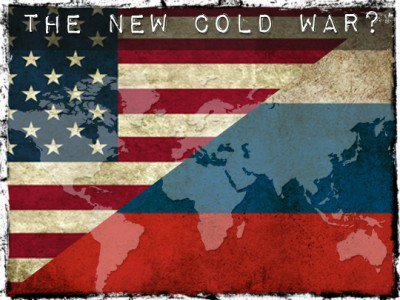
The director of PEN Moscow is worried about Russophobia.
By Nadezhda Azhgikhina, The Nation, 5/18/23
Thirty-two years ago, in the spring of 1991, I first came to New York, to attend the Glasnost in Two Cultures conference of women writers in Russia and North America. It was my first real trip abroad. Going to America at the time was like going to the moon for Soviet people.
The flight itself took almost a day, with stops in Ireland and Newfoundland. Soviet citizens could take out only $30 regardless of the duration of the trip; there was only one bank where rubles could be changed for dollars, and people had to sign up for an appointment a week in advance.
The lucky ones “back from the moon” described the incredible number of VCRs and varieties of sausage. Soviet TV showed gleaming Fifth Avenue storefronts and strolling ladies with dogs instead of the usual propaganda reports from slums. In Russia at this time, there were shortages of the most basic products.
The first thing that struck me about New York was the endless variety of people, cultures, and museums, as well as the very rhythm of the city, which was similar to Moscow’s. I immediately felt at home here. Early in the morning before the conference, I went out to Washington Square, where students were lying and sitting on the grass, and there was a hotdog stand on the corner, the smell mingling with the smell of apple blossoms. When I bought a hotdog, the vendor asked where I was from and was happy to hear that I was from Moscow. Gorbachev! Everybody then was interested in what was going on in the USSR, how people lived, what they thought.
The conference, organized by New York University and the Modern Literary Association, was the first large-scale meeting of Slavists, American feminists, and Russian women writers; it gave an energetic start to dozens of new projects, books, and translations, and, most importantly, to regular personal contacts and dialogues. “People Instead of Reinforced Concrete” was the title of my article in the magazine Ogonyok about these meetings, referring to the fact that the “Iron Curtain” was broken by people from both sides who believed in a new, free, more perfect world without stereotypes, without hatred and hostility. Then, Americans started to come regularly and stay to live in Russia for long periods of time, and Russians began to live in America. The Moscow–New York flight became part of the professional and personal lives of many on both sides of the ocean.
I haven’t been to New York in almost three years, since the pandemic began. So much has changed in the world. The Covid pandemic closed down life. The Ukraine war has revealed the fragility of longtime relations and the cruelty of wars of attrition. Many things were frighteningly reminiscent of my childhood experiences during the Cold War. It seemed like the Iron Curtain was suddenly and rapidly coming down on both sides. I was on my way to meet friends and understand what was going on.
Today, once again, a trip to the US for Russians is like a trip to the moon, the way it was in 1991. To renew your visa, you have to go to another country for an interview and live there for more than a week, waiting for processing. There are no more direct and cheap flights from Russia (the trip takes about a day, with connections), and instead of $500–700, economy class now costs about $1,500–2,000. Russian banks are disconnected from the international system, so, just as in the 1990s, you need cash. But cash is not taken everywhere. My first encounter with the New York subway in April 2023 turned out to be an unpleasant surprise: The subway pass could be bought only by credit card and I had to take a cab, which cost three times as much as it had in 2020.
In 1991, the first thing I saw on TV in America was Donald Trump and demonstrations with portraits of Lenin in Moscow. Then I was afraid that perestroika was dead, and I rushed to call home. It turned out to be okay: They were showing the daily pickets on Mayakovsky Square. In the spring of 2023, there were debates on TV about the upcoming election, Zelensky demanding guns, and Trump again. “Of course, we should give Ukraine more weapons,” said a friend, pouring tea, “but so that they don’t reach Moscow.” I got scared.
My friends asked if there was food in the stores. I said that there was, that the brands that were no longer available in the country were still sold by boutiques, that in general you could buy anything if you had money. An acquaintance asked me to meet her neighbors, who wanted to hear from a person from Moscow.
“Everyone knows that Russia is the greatest evil in the world, a threat to humanity and progress,” a respectable elderly gentleman began the conversation. “What should we do about this evil?” I told him about a neighbor at my dacha near Moscow, a lover of Russian vodka and political TV shows; after the first drink, he always said that the United States dreamed of making all Russians slaves. I said that many Russians, despite the propaganda, have an interest and sympathy for Americans, that I recently attended a conference in Moscow about American culture. And many students and scholars cannot come to the United States because of sanctions that hit not politicians and oligarchs but millions of ordinary citizens, primarily the middle class and intellectuals. The sanctions are leading some people to agree with the propaganda. The gathered neighbors recalled how they met Russians in the 1990s, and how interesting it was to socialize with them.
At two universities where I visited Slavic culture departments, I was the first guest from Moscow since the pandemic began. I heard about how Russian programs were being closed, how funding was being cut, how scholars from Russia were being removed from conferences. One colleague (who left the USSR in the 1980s to escape anti-Semitism) recently lost her seat on the board of a prestigious association—she was born in the USSR, and the board did not like it. Fortunately, the Association for Slavic, East European, and Eurasian Studies (ASEEES) opposes the “abolition of Russian culture” and even invites Russian researchers to participate in conferences. But this seemed to me almost heroic.
Colleagues asked if there were any scholars and journalists left in Russia, having read in the press that everybody had left. I told them about the recent 30th anniversary of Novaya Gazeta in Moscow; about the work of the editorial board under hard pressure; about the new independent online media, which appears in megalopolises and small towns almost every month (I enumerated a couple of dozen of them from memory). I also told them about the work of Memorial, about crisis centers and other NGOs (including those on the list of “foreign agents”) that help people. About the new phenomenon of thousands of people sending money every day to independent media and NGOs in order to pay for the fines of activists, and to help refugees in all regions of the vast country. About local deputies from the Yabloko party, who won elections on a platform for peace.
“We haven’t read about that anywhere,” said a colleague. “How can we help them?”
Thirty years ago, Russians and Americans discovered each other. In that time together, they managed to create professional and civic communities and to tell a wide audience about it. Now, it looks like we have to start all over again. However, the experience of 30 years cannot be undone.
The main thing we can do for each other is not to lose touch and to remember that our common future depends on us, too. This is what Track Two Citizen Diplomacy, ASEEES, and groups like Women Transforming Our Nuclear Legacy are talking about today in America: that history is made by people. And we will make it. I believe that.
Megyn Kelly Interviews Tara Reade on Her Recent Decision to Stay in Russia Due to Fears of Arrest if She Returns to US
Link here.
Juan Cole: China & the Axis of the Sanctioned
By Juan Cole, Consortium News, 5/19/23
A photo Beijing released on March 6 delivered a seismic shock in Washington.
There was Wang Yi, a top foreign Chinese foreign affairs official, standing between Ali Shamkhani, the secretary of Iran’s National Security Council, and Saudi National Security Adviser Musaad bin Mohammed al-Aiban. They were awkwardly shaking hands on an agreement to reestablish mutual diplomatic ties.
That picture should have brought to mind a 1993 photo of President Bill Clinton hosting Israeli Prime Minister Yitzhak Rabin and PLO chief Yasser Arafat on the White House lawn as they agreed to the Oslo Accords. And that long-gone moment was itself an after-effect of the air of invincibility the United States had gained in the wake of the collapse of the Soviet Union and the overwhelming American victory in the 1991 Gulf War.
This time around, the U.S. had been cut out of the picture, a sea change reflecting not just Chinese initiatives but Washington’s incompetence, arrogance, and double-dealing in the subsequent three decades in the Middle East.
An aftershock came in early May as concerns gripped Congress about the covert construction of a Chinese naval base in the United Arab Emirates, a U.S. ally hosting thousands of American troops. The Abu Dhabi facility would be an add-on to the small base at Djibouti on the east coast of Africa used by the People’s Liberation Army-Navy for combating piracy, evacuating noncombatants from conflict zones, and perhaps regional espionage.
China’s interest in cooling off tensions between the Iranian ayatollahs and the Saudi monarchy arose, however, not from any military ambitions in the region but because it imports significant amounts of oil from both countries. Another impetus was undoubtedly Xi’s ambitious Belt and Road Initiative, or BRI, that aims to expand Eurasia’s overland and maritime economic infrastructure for a vast growth of regional trade — with China, of course, at its heart.
China has already invested billions in a China-Pakistan Economic Corridor and in developing the Pakistani Arabian seaport of Gwadar to facilitate the transmission of Gulf oil to its northwestern provinces.
Having Iran and Saudi Arabia on a war footing endangered Chinese economic interests. Remember that, in September 2019, an Iran proxy or Iran itself launched a drone attack on the massive refinery complex at al-Abqaiq, briefly knocking out 5 million barrels a day of Saudi capacity.

Map and satellite imagery of the Abqaiq — Biqayq in Arabic— and Khurais facilities attacked by drones on Sept. 14, 2019. (VOA, Public domain, Wikimedia Commons)
That country now exports a staggering 1.7 million barrels of petroleum daily to China and future drone strikes (or similar events) threaten those supplies. China is also believed to receive as much as 1.2 million barrels a day from Iran, though it does so surreptitiously because of U.S. sanctions.
In December 2022, when nationwide protests forced the end of Xi’s no-Covid lockdown measures, that country’s appetite for petroleum was once again unleashed, with demand already up 22 percent over 2022.
So, any further instability in the Gulf is the last thing the Chinese Communist Party needs right now. Of course, China is also a global leader in the transition away from petroleum-fueled vehicles, which will eventually make the Middle East far less important to Beijing. That day, however, is still 15 to 30 years away.
Things Could Have Been Different
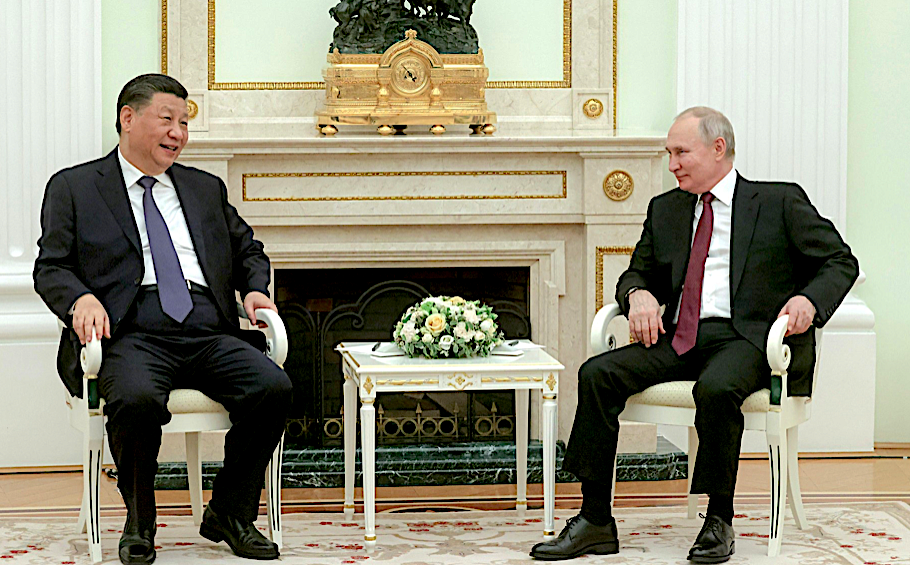
China’s President Xi Jinping with Russian President Vladimir Putin on March 20 in Moscow. (Sergei Karpukhin, TASS)
China’s interest in bringing to an end the Iranian-Saudi cold war, which constantly threatened to turn hotter, is clear enough, but why did those two countries choose such a diplomatic channel?
After all, the United States still styles itself the “indispensable nation.” If that phrase ever had much meaning, however, American indispensability is now visibly in decline, thanks to blunders like allowing Israeli right-wingers to cancel the Oslo peace process, the launching of an illegal invasion of and war in Iraq in 2003 and the grotesque Trumpian mishandling of Iran.
Distant as it may be from Europe, Tehran might nonetheless have been brought into NATO’s sphere of influence, something President Barack Obama spent enormous political capital trying to achieve. Instead, then-President Donald Trump pushed it directly into the arms of Vladimir Putin’s Russian Federation and Xi’s China.
Things could indeed have been different. With the 2015 Joint Comprehensive Plan of Action (JCPOA) nuclear deal, brokered by the Obama administration, all practical pathways for Iran to build nuclear weapons were closed off.
It’s also true that Iran’s ayatollahs have long insisted they don’t want a weapon of mass destruction that, if used, would indiscriminately kill potentially vast numbers of non-combatants, something incompatible with the ethics of Islamic law.
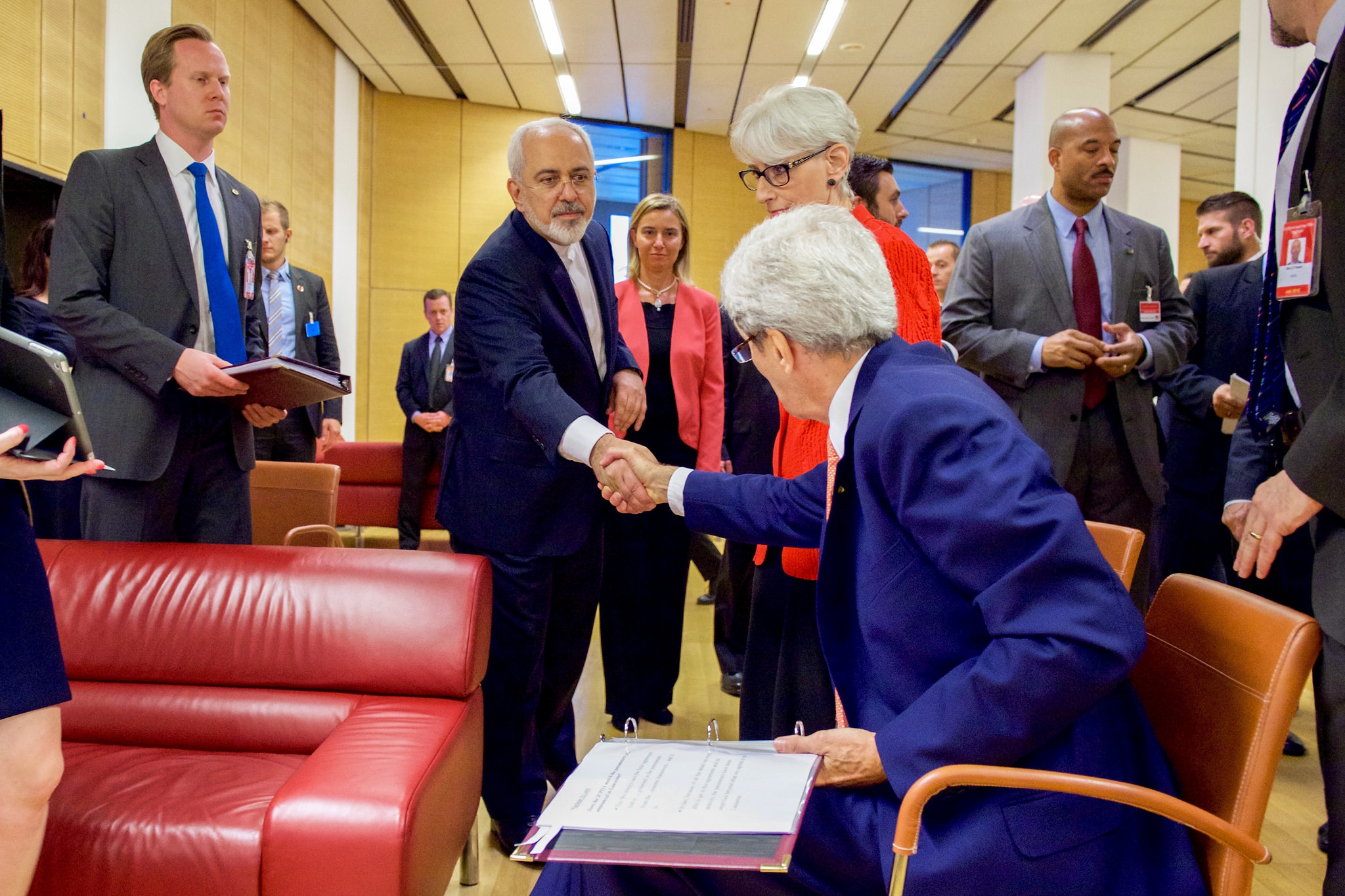
July 14, 2015: U.S. Secretary of State John Kerry, seated, shakes hands in parting with Iranian Foreign Minister Javad Zarif in Vienna after Zarif read a declaration of the nuclear agreement in his native Farsi. (State Department)
Whether one believes that country’s clerical leaders or not, the JCPOA made the question moot, since it imposed severe restrictions on the number of centrifuges Iran could operate, the level to which it could enrich uranium for its nuclear plant at Bushehr, the amount of enriched uranium it could stockpile, and the kinds of nuclear plants it could build.
According to the inspectors at the U.N.’s International Atomic Energy Agency, Iran faithfully implemented its obligations through 2018 and — consider this an irony of our Trumpian times — for such compliance it would be punished by Washington.
Iran’s Ayatollah Ali Khamenei only permitted President Hassan Rouhani to sign that somewhat mortifying treaty with the permanent members of the U.N. Security Council in return for promised relief from Washington’s sanctions (that they never got).
In early 2016, the Security Council did indeed remove its own 2006 sanctions on Iran. That, however, proved a meaningless gesture because by then Congress, deploying the Department of the Treasury’s Office of Foreign Assets Control, had slapped unilateral American sanctions on Iran and, even in the wake of the nuclear deal, congressional Republicans refused to lift them. They even nixed a $25 billion deal that would have allowed Iran to buy civilian passenger jets from Boeing.
Worse yet, such sanctions were designed to punish third parties that contravened them. French firms like Renault and TotalEnergies were eager to jump into the Iranian market but feared reprisals. The U.S. had, after all, fined French bank BNP $8.7 billion for skirting those sanctions and no European corporation wanted a dose of that kind of grief.
In essence, congressional Republicans and the Trump administration kept Iran under such severe sanctions even though it had lived up to its side of the bargain, while Iranian entrepreneurs eagerly looked forward to doing business with Europe and the United States.
In short, Tehran could have been pulled inexorably into the Western orbit via increasing dependence on North Atlantic trade deals, but it was not to be.
And keep in mind that Israeli Prime Minister (then as now) Benjamin Netanyahu had lobbied hard against the JCPOA, even going over Obama’s head in an unprecedented fashion to encourage Congress to nix the deal.
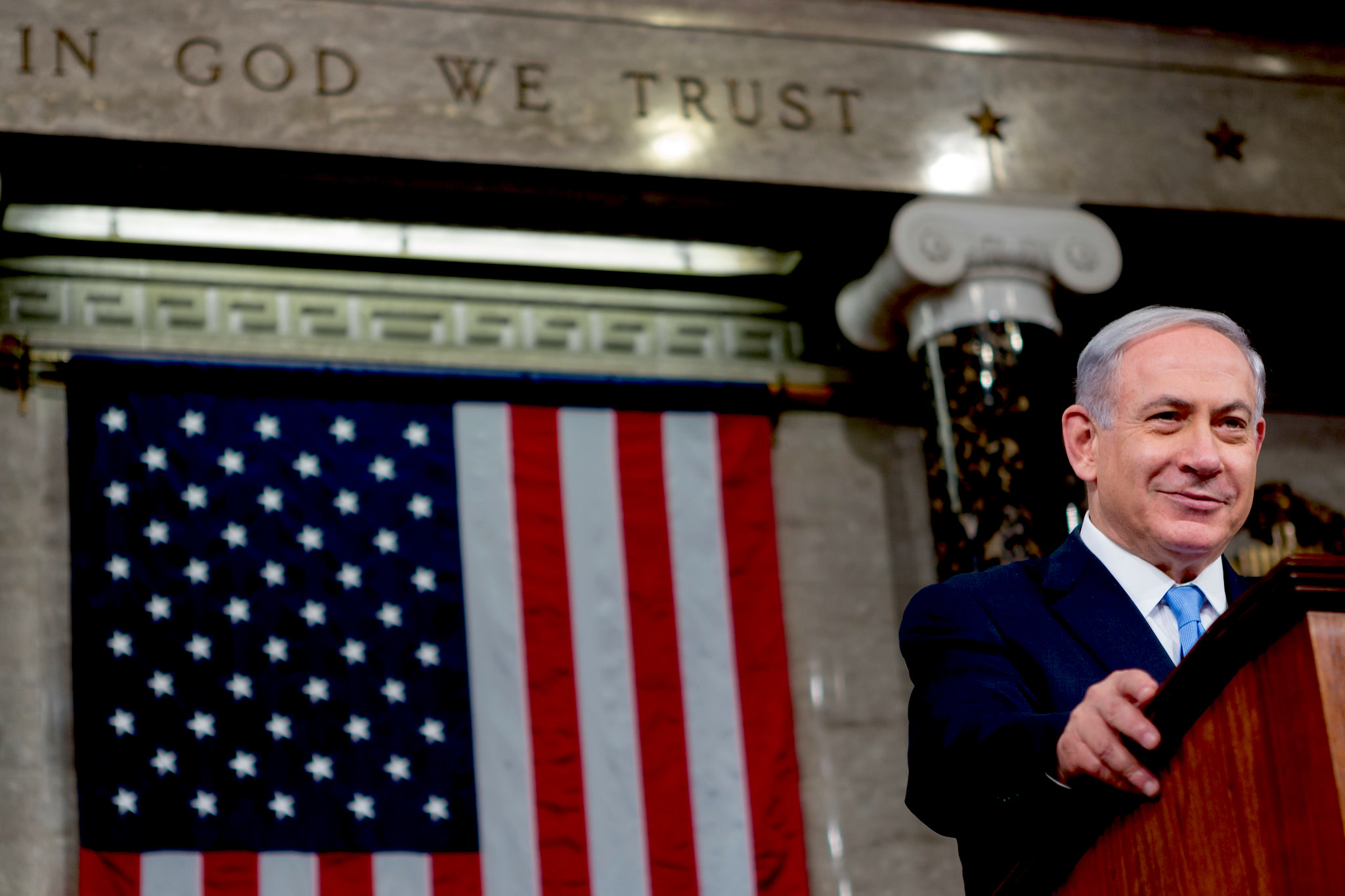
March 3, 2015: Israel’s Prime Minister Benjamin Netanyahu addresses a joint meeting of Congress. (Speaker John Boehner, Flickr, CC BY-NC 2.0)
That effort to play spoiler failed — until, in May 2018, Trump simply tore up the treaty. Netanyahu was caught on tape boasting that he had convinced the gullible Trump to take that step. Although the Israeli right wing insisted that its greatest concern was an Iranian nuclear warhead, it sure didn’t act that way. Sabotaging the 2015 deal actually freed that country from all constraints.
Netanyahu and like-minded Israeli politicians were, it seems, upset that the JCPOA only addressed Iran’s civilian nuclear enrichment program and didn’t mandate a rollback of Iranian influence in Lebanon, Iraq, and Syria, which they apparently believed to be the real threat.
Trump went on to impose what amounted to a financial and trade embargo on Iran. In its wake, trading with that country became an increasingly risky proposition. By May 2019, Trump had succeeded handsomely by his own standards (and those of Netanyahu).
He had managed to reduce Iran’s oil exports from 2.5 million barrels a day to as little as 200,000 barrels a day. That country’s leadership nonetheless continued to conform to the requirements of the JCPOA until mid-2019, after which they began flaunting its provisions. Iran has now produced highly enriched uranium and is much closer to being capable of making nuclear weapons than ever before, though it still has no military nuclear program and the ayatollahs continue to deny that they want such weaponry.
Support CN’s Spring
Fund Drive Today
In reality, Trump’s “maximum pressure campaign” did anything but destroy Tehran’s influence in the region. In fact, if anything, in Lebanon, Syria, and Iraq the power of the ayatollahs was only strengthened.
After a while, Iran also found ways to smuggle its petroleum to China, where it was sold to small private refineries that operated solely for the domestic market. Since those firms had no international presence or assets and didn’t deal in dollars, the Treasury Department had no way of moving against them.
In this fashion, Trump and congressional Republicans ensured that Iran would become deeply dependent on China for its very economic survival — and so also ensured the increasing significance of that rising power in the Middle East.
The Saudi Reversal

Crown Prince of Saudi Arabia Mohammad bin Salman in 2019. (Kremlin)
When Russia invaded Ukraine in February 2022, oil prices spiked, benefiting the Iranian government. The Biden administration then imposed the kind of maximum-pressure sanctions on the Russian Federation that Trump had levied against Iran. Unsurprisingly, a new Axis of the Sanctioned has now formed, with Iran and Russia exploring trade and arms deals and Iran allegedly providing drones to Moscow for its war effort in Ukraine.
As for Saudi Arabia, its de facto leader, Crown Prince Mohammed bin Salman, recently seemed to get a better set of advisers. In March 2015, he had launched a ruinous and devastating war in neighboring Yemen after the Zaydi Shiite “Helpers of God,” or Houthi rebels, took over the populous north of that country.
Since the Saudis were primarily deploying air power against a guerrilla force, their campaign was bound to fail. The Saudi leadership then blamed the rise and resilience of the Houthis on the Iranians. While Iran had indeed provided some money and smuggled some weapons to the Helpers of God, they were a local movement with a long set of grievances against the Saudis. Eight years later, the war has sputtered to a devastating stalemate.
The Saudis had also attempted to counter Iranian influence elsewhere in the Arab world, intervening in the Syrian civil war on the side of fundamentalist Salafi rebels against the government of autocrat Bashar al-Assad.
In 2013, Lebanon’s Shiite Hezbollah militia joined the fray in support of al-Assad and, in 2015, Russia committed air power there to ensure the rebels’ defeat. China had also backed al-Assad (though not militarily) and played a quiet role in the post-war reconstruction of the country.
As part of that recent China-brokered agreement to reduce tensions with Iran and its regional allies, Saudi Arabia just spearheaded a decision to return the al-Assad government to membership in the Arab League (from which it had been expelled in 2011 at the height of the Arab Spring revolts).
By late 2019, in the wake of that drone attack on the Abqaiq refineries, it was already clear that Bin Salman had lost his regional contest with Iran and Saudi Arabia began to seek some way out.
Among other things, the Saudis reached out to the Iraqi prime minister of that moment, Adil Abdel Mahdi, asking for his help as a mediator with the Iranians. He, in turn, invited General Qasem Soleimani, the head of the Jerusalem Brigade of the Iranian Revolutionary Guards Corps, to Baghdad to consider a new relationship with the House of Saud.
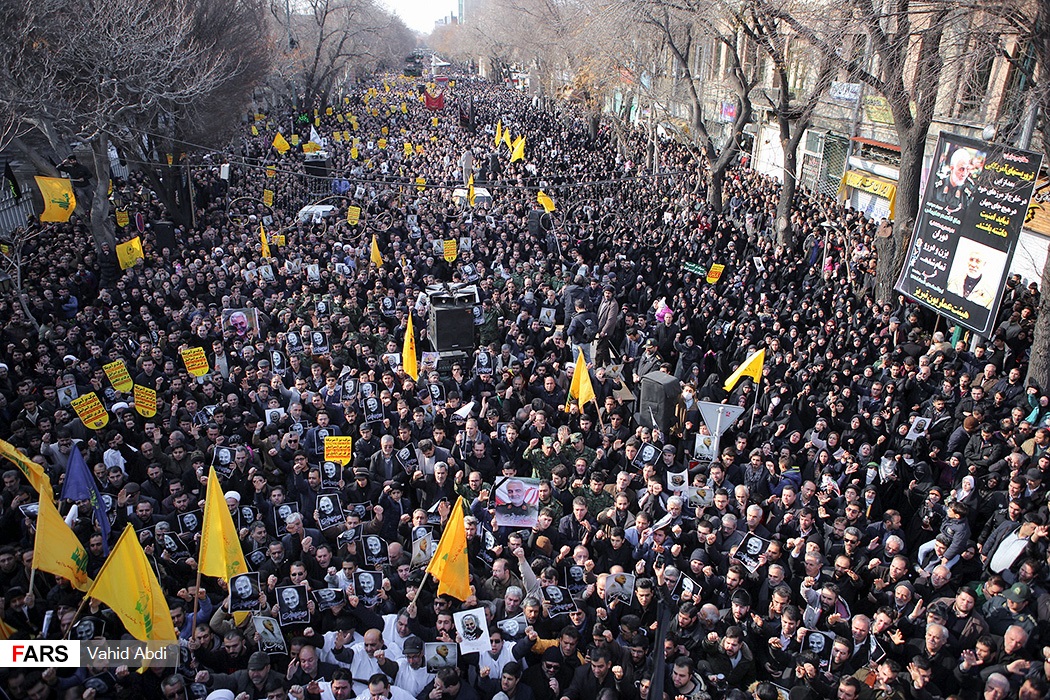
Demonstrations in Iran over the killing of Qassem Soleimani. (Fars News Agency, CC BY 4.0, Wikimedia Commons)
As few will forget, on Jan. 3, 2020, Soleimani flew to Iraq on a civilian airliner only to be assassinated by an American drone strike at Baghdad International Airport on the orders of Trump who claimed he was coming to kill Americans.
Did Trump want to forestall a rapprochement with the Saudis? After all, marshaling that country and other Gulf states into an anti-Iranian alliance with Israel had been at the heart of his son-in-law Jared Kushner’s “Abraham Accords.”
The Rise of China, the Fall of America
Washington is now the skunk at the diplomats’ party. The Iranians were never likely to trust the Americans as mediators. The Saudis must have feared telling them about their negotiations lest the equivalent of another Hellfire missile be unleashed. As 2022 ended, Xi actually visited the Saudi capital Riyadh, where relations with Iran were evidently a topic of conversation.
This February, Iranian President Ebrahim Raisi traveled to Beijing by which time, according to the Chinese Foreign Ministry, Xi had developed a personal commitment to mediating between the two Gulf rivals. Now, a rising China is offering to launch other Middle Eastern mediation efforts, while complaining “that some large countries outside the region” were causing “long-term instability in the Middle East” out of “self-interest.”
China’s new prominence as a peacemaker may soon extend to conflicts like the ones in Yemen and Sudan. As the rising power on this planet with its eye on Eurasia, the Middle East, and Africa, Beijing is clearly eager to have any conflicts that could interfere with its Belt and Road Initiative resolved as peaceably as possible.
Although China is on the cusp of having three aircraft carrier battle groups, they continue to operate close to home and American fears about a Chinese military presence in the Middle East are, so far, without substance.
Where two sides are tired of conflict, as was true with Saudi Arabia and Iran, Beijing is clearly now ready to play the role of the honest broker.
Its remarkable diplomatic feat of restoring relations between those countries, however, reflects less its position as a rising Middle Eastern power than the startling decline of American regional credibility after three decades of false promises (Oslo), debacles (Iraq) and capricious policy-making that, in retrospect, appears to have relied on nothing more substantial than a set of cynical imperial divide-and-rule ploys that are now so been-there, done-that.
Juan Cole, a TomDispatch regular, is the Richard P. Mitchell collegiate professor of history at the University of Michigan. He is the author of The Rubaiyat of Omar Khayyam: A New Translation From the Persian and Muhammad: Prophet of Peace Amid the Clash of Empires. His latest book is Peace Movements in Islam. His award-winning blog is Informed Comment. He is also a non-resident Fellow of the Center for Conflict and Humanitarian Studies in Doha and of Democracy for the Arab World Now (DAWN).
This article is from TomDispatch.com.
Medea Benjamin & Nicholas JS Davies: G7 Versus Diplomacy for Ukraine

By Medea Benjamin & Nicholas JS Davies, Consortium News, 5/31/23
When Japan invited the leaders of Brazil, India and Indonesia to attend the G7 summit in Hiroshima, there were glimmers of hope that it might be a forum for these rising economic powers from the Global South to discuss their advocacy for peace in Ukraine with the wealthy Western G7 countries that are militarily allied with Ukraine and have so far remained deaf to pleas for peace.
But it was not to be. Instead, the Global South leaders were forced to sit and listen as their hosts announced their latest plans to tighten sanctions against Russia and further escalate the war by sending U.S.-built F-16 warplanes to Ukraine.
The G7 summit stands in stark contrast to efforts of leaders from around the world who are trying to end the conflict. In the past, the leaders of Turkey, Israel and Italy have stepped up to try to mediate. Their efforts were bearing fruit back in April 2022, but were blocked by the West, particularly the U.S. and U.K., which did not want Ukraine to make an independent peace agreement with Russia.
Now that the war has dragged on for over a year with no end in sight, other leaders have stepped forward to try to push both sides to the negotiating table. In an intriguing development, Denmark, a NATO country, has stepped forward to offer to host peace talks. On May 22, just days after the G7 meeting, Danish Foreign Minister Lars Løkke Rasmussen said that his country would be ready to host a peace summit in July if Russia and Ukraine agreed to talk.
“We need to put some effort into creating a global commitment to organize such a meeting,” said Rasmussen, mentioning that this would require getting support from China, Brazil, India and other nations that have expressed interest in mediating peace talks. Having an EU and NATO member promoting negotiations may well reflect a shift in how Europeans view the path forward in Ukraine.
Also reflecting this shift is a report by Seymour Hersh, citing U.S. intelligence sources, that the leaders of Poland, Czechia, Hungary and the three Baltic states, all NATO members, are talking to Ukraine’s President Volodymyr Zelensky about the need to end the war and start rebuilding Ukraine so that the 5 million refugees now living in their countries can start to return home.
On May 23, right-wing Hungarian President Viktor Orban said, “Looking at the fact that NATO is not ready to send troops, it’s obvious that there is no victory for poor Ukrainians on the battlefield,” and that the only way to end the conflict was for Washington to negotiate with Russia.
Meanwhile, China’s peace initiative has been progressing, despite U.S. trepidation. Li Hui, China’s special representative for Eurasian affairs and former ambassador to Russia, has met with Russian President Vladimir Putin, Zelensky, Ukraine’s Foreign Minister Dmytro Kuleba and other European leaders to move the dialogue forward. Given its position as both Russia’s and Ukraine’s top trading partner, China is in a good position to engage with both sides.
Lula Appoints Peace Envoy
Another initiative has come from President Lula da Silva of Brazil, who is creating a “peace club” of countries from around the world to work together to resolve the conflict in Ukraine. He appointed renowned diplomat Celso Amorim as his peace envoy.
Amorim was Brazil’s foreign minister from 2003 to 2010, and was named the “world’s best foreign minister” in Foreign Affairs magazine. He also served as Brazil’s defense minister from 2011 to 2014, and is now Lula’s chief foreign policy adviser. Amorim has already had meetings with Putin in Moscow and Zelenskyy in Kyiv, and was well received by both parties.
On May 16, South African President Cyril Ramaphosa and other African leaders stepped into the fray, reflecting just how seriously this war is affecting the global economy through rising prices for energy and food. Ramaphosa announced a high-level mission by six African presidents, led by President Macky Sall of Senegal. He served, until recently, as Chairman of the African Union and, in that capacity, spoke out forcefully for peace in Ukraine at the U.N. General Assembly in September 2022.
The other members of the mission are Presidents Denis Sassou Nguesso of Congo, Abdel Al-Sisi of Egypt, Yoweri Musevini of Uganda and Hakainde Hichilema of Zambia. The African leaders are calling for a ceasefire in Ukraine, to be followed by serious negotiations to arrive at “a framework for lasting peace.” U.N. Secretary-General Guterres has been briefed on their plans and has “welcomed the initiative.”
Pope Francis and the Vatican are also seeking to mediate the conflict. “Let us not get used to conflict and violence. Let us not get used to war,” the pope preached. The Vatican has already helped facilitate successful prisoner exchanges between Russia and Ukraine, and Ukraine has asked for the pope’s help in reuniting families that have been separated by the conflict. A sign of the pope’s commitment is his appointment of veteran negotiator Cardinal Matteo Zuppi as his peace envoy. Zuppi was instrumental in mediating talks that ended civil wars in Guatemala and Mozambique.
Will any of these initiatives bear fruit? The possibility of getting Russia and Ukraine to talk depends on many factors, including their perceptions of potential gains from continued combat, their ability to maintain adequate supplies of weapons, and the growth of internal opposition. But it also depends on international pressure, and that is why these outside efforts are so critical and why U.S. and NATO countries’ opposition to talks must somehow be reversed.
The U.S. rejection or dismissal of peace initiatives illustrates the disconnect between two diametrically opposed approaches to resolving international disputes: diplomacy vs. war. It also illustrates the disconnect between rising public sentiment against the war and the determination of U.S. policymakers to prolong it, including most Democrats and Republicans.
A growing grassroots movement in the U.S. is working to change that:
- In May, foreign policy experts and grassroots activists put out paid advertisements in The New York Times and The Hill to urge the U.S. government to be a force for peace. The Hill ad was endorsed by 100 organizations around the country, and community leaders organized in dozens of congressional districts to deliver the ad to their representatives.
- Faith-based leaders, over 1,000 of whom signed a letter to President Biden in December calling for a Christmas Truce, are showing their support for the Vatican’s peace initiative.
- The U.S. Conference of Mayors, an organization that represents about 1,400 cities throughout the country, unanimously adopted a resolution calling on the President and Congress to “maximize diplomatic efforts to end the war as soon as possible by working with Ukraine and Russia to reach an immediate ceasefire and negotiate with mutual concessions in conformity with the United Nations Charter, knowing that the risks of wider war grow the longer the war continues.”
- Key U.S. environmental leaders have recognized how disastrous this war is for the environment, including the possibility of a catastrophic nuclear war or an explosion in a nuclear power plant, and have sent a letter to President Biden and Congress urging a negotiated settlement.
- On June 10-11, U.S. activists will join peacemakers from all over the world in Vienna, Austria, for an International Summit for Peace in Ukraine.
- Some of the contenders running for president, on both the Democratic and Republican tickets, support a negotiated peace in Ukraine, including Robert F. Kennedy and Donald Trump.
The initial decision of the United States and NATO member countries to try to help Ukraine resist the Russian invasion had broad public support.
However, blocking promising peace negotiations and deliberately choosing to prolong the war as a chance to “press” and “weaken” Russia changed the nature of the war and the U.S. role in it, making Western leaders active parties to a war in which they will not even put their own forces on the line. [Consortium News argues that the nature of the war didn’t change; it was the nature of the Western war from the beginning.]
Must our leaders wait until a murderous war of attrition has killed an entire generation of Ukrainians, and left Ukraine in a weaker negotiating position than it was in April 2022, before they respond to the international call for a return to the negotiating table?
Or must our leaders take us to the brink of World War III, with all our lives on the line in an all-out nuclear war, before they will permit a ceasefire and a negotiated peace?
Medea Benjamin is co-founder of Global Exchange and CODEPINK: Women for Peace. She is the co-author, with Nicolas J.S. Davies, of War in Ukraine: Making Sense of a Senseless Conflict, available from OR Books in November 2022. Other books include, Inside Iran: The Real History and Politics of the Islamic Republic of Iran (2018); Kingdom of the Unjust: Behind the U.S.-Saudi Connection (2016); Drone Warfare: Killing by Remote Control (2013); Don’t Be Afraid Gringo: A Honduran Woman Speaks from the Heart (1989), and with Jodie Evans, Stop the Next War Now (2005).
Nicolas J. S. Davies is an independent journalist and a researcher with CODEPINK. He is the co-author, with Medea Benjamin, of War in Ukraine: Making Sense of a Senseless Conflict, available from OR Books and the author of Blood On Our Hands: the American Invasion and Destruction of Iraq.
This article is from Common Dreams.